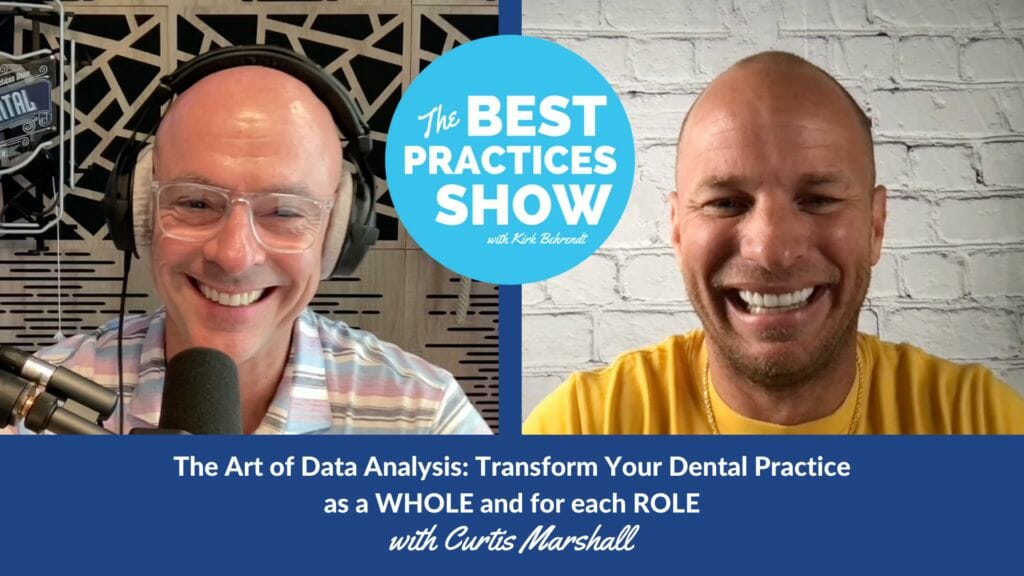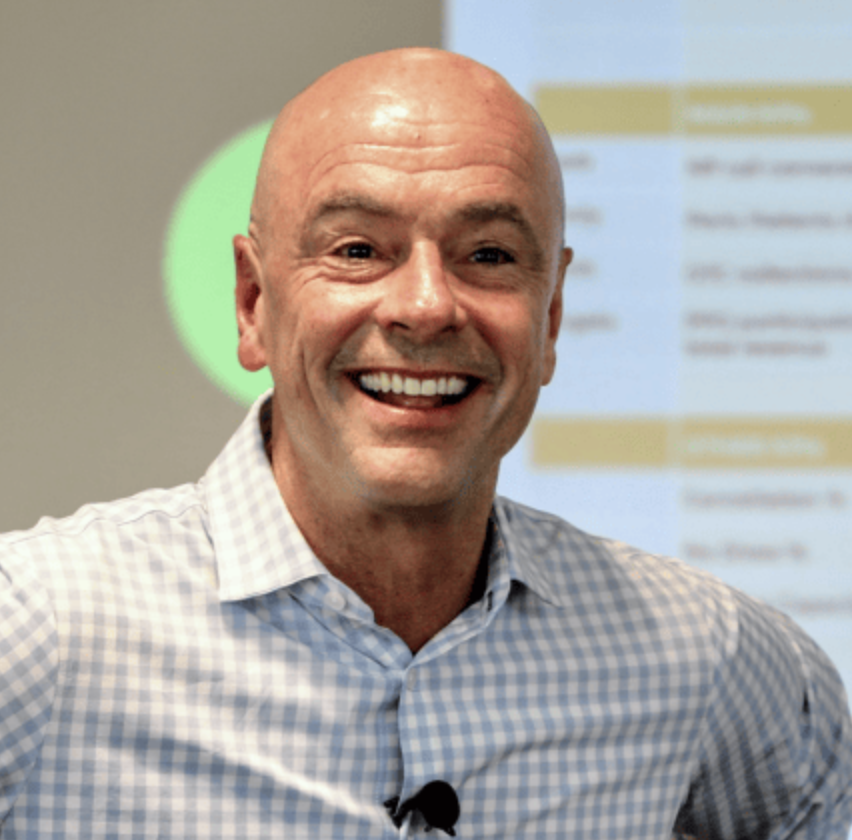
Episode #605: The Art Of Data Analysis: Transform Your Dental Practice As A WHOLE And For Each ROLE, With Curtis Marshall
Are you looking at an ocean of data for your practice and letting the fear of drowning prevent you from making improvements? Today Kirk Behrendt brings on Curtis Marshall of Dental Intelligence to explain the art of data analysis and how to maximize its potential. Transforming your practice as a whole and for each role doesn’t have to be complex—find out how to simplify the process on episode 605 of The Best Practices Show!
Episode Resources:
- Subscribe to the Best Practices Show Podcast
- Join ACT’s To The Top Study Club
- Join ACT’s Master Class
- See our Live Events Schedule here
- Get the Best Practices Magazine for Free!
- Write a Review on iTunes
Links Mentioned in This Episode:
Download the list of KPI benchmarks
Find out more about Dental Intelligence
Main Takeaways:
Data removes all emotion
Understand and track your hygiene department KPI benchmarks
Focus on the individual roles in order to improve the whole
Be transparent with your team about your metrics
Focus on improving specific metrics instead of chasing them all
Quotes:
“So the whole, meaning, ‘Hey, here’s everything that’s happening in your practice,’ right, the high level, everything that’s going on. The role meaning as an individual, what should I be focusing on? And we have many different team members in different roles in the office. Some people might be two or three different roles, so I’m not saying people, we’re saying roles, like what you need to be looking at.” (06:15—06:41)
“We pull all the data and information out of people’s practice management software, so all the ones and zeros, we don’t pull the reports because the practice management software makes their own reports. We pull the raw data, clean it up, and give you a whole bunch of metrics that if you’re like Kirk and his team, you’re going to read those and understand it. You have a decoder, and you know how to read it. But for the roles in the office and what different team members, looking in that see could be very difficult.” (06:48—07:23)
“Here’s what we typically do. We take the whole and then we go to the team and say, ‘This is the problem. Go fix it.’ And everybody goes in different directions to try to fix something, yet they don’t know if it’s going to be related to or not. And they come back and they’re like, ‘I’m exhausted’ or ‘This is what I did,’ or ‘I forgot.’” (09:31—09:52)
“[For hygiene] you want to compare, know the delta, the difference between your active patients, patients who have been in your office in the last 18 months, versus how many are in your hygiene program.” (10:19—10:38)
“Okay, So I have my 2000 active patients. Out of those active patients, let’s just make numbers easy. 1000, or 50%, of them are in my hygiene department. Of those thousand in your hygiene department, you want to know how many of those hygiene patients currently, as of today, have a future hygiene appointment. That is pre-appointment percentage. Let me say it again. Pre appointment percentage for hygiene is: number one, ‘Have they been in your hygiene program?’ Number two, ‘Do they currently have a future hygiene appointment?’” (12:31—13:13)
“Even if everyone left with a future hygiene appointment, your whole, everything is not always going to be 100% because patients will call and cancel and not reschedule. That as of today goes down. Great job on the day they were here. Good job. Everyone left. But of my whole, how many do not have a future appointment will be much less than how many they leave with.” (14:47—15:18)
“One area of the role is making sure everyone left with a future appointment. In this fake example that we’re giving, do we need to focus and pay attention to that anymore? If everyone’s leaving with a future appointment, do we need to worry about that? No. Hey, it’s good. It’s going great. You can celebrate, but you don’t really need to track that 100% anymore, because everyone truly is leaving with an appointment.” (17:05—17:33)
“But if my whole is saying, ‘Hey, this is not right, there’s something wrong,’ there’s another role that needs to be fixed. And that role in this scenario would 100% be about breaking appointments. If they break an appointment, are we rescheduling them? Do we have a follow up with them? How is that system working?” (17:34—17:59)
“Let’s now start tracking all of the broken appointments and how many of them reappoint. That is the role. The role we’re now focusing on, in talking to patients and improving, the role is ‘Of my broken patients, how many are we getting to reschedule?’” (18:15—18:36)
“In order to accomplish the whole, to improve your 10% of patients in perio, to increase that 10%, the role is looking at two maybe three different roles, but one role being diagnostic percentage.” (26:49—27:08)
“The second would be acceptance percentage of perio. So those two roles now, I can now talk with the roles of diagnostic. Are the hygienist and the doctor working together to find true perio? And that’s up to the clinicians—they’ll decide that. Then we’d look at the acceptance. How well are they accepting? Now that could be the hygienist, the doctor, and the treatment coordinator, but those would be the two roles that we’re going to be focusing on to increase the whole.” (27:14—27:51)
“I don’t know necessarily what to do if you tell me the whole. But when we talk about the role of really, ‘Hey, this is what we’re going to do,’ and if we do this, then I’m going to love the whole.” (28:04—28:16)
“Because so many times we see a number, and we either say, ‘Team, you need to go fix this big whole number.’ No, no. They’re going to do things that may or may not fix it. Give them the role. ‘This is the area we want you to be focusing on. And I know I’m not necessarily going to say it, but I know it’s going to improve the whole of the company. But I need you to focus on the role.’” (31:09—31:39)
Snippets:
0:00 Introduction.
02:16 Curtis’ background.
05:03 Whole vs. Role.
07:37 Hygiene department metrics.
09:09 How many of your active patients are hygiene patients?
12:20 Hygiene pre-appointment percentage.
15:28 The role of fixing broken appointments.
19:59 Hygiene reappointment percentage.
24:13 The power of being transparent with your numbers.
25:22 Importance of perio percentage.
28:17 Don’t try to improve every metric at once.
32:11 Last thoughts.
Curtis Marshall Bio:
Nationwide dentists have allowed Curtis Marshall to utilize his passion and skills to take
their practice to the next level. With over 10 years’ experience of marketing and
communication, and 8 years’ experience of practice management, dental coaching, and
operations, dentists love the advantage they get through working with him.
While working in a general practice Curtis used his expertise with systems and
marketing to help a single doctor grow from 20 new patients a month to being a 3-doctor
practice with 400 new patients a month, and $6 million annually.
Curtis is a fantastic motivator and has helped our company with numerous successful
marketing projects. He is energetic, charismatic, personal, and the kind of guy who
makes friends wherever he goes.
Kirk Behrendt
Kirk Behrendt is a renowned consultant and speaker in the dental industry, known for his expertise in helping dentists create better practices and better lives. With over 30 years of experience in the field, Kirk has dedicated his professional life to optimizing the best systems and practices in dentistry. Kirk has been a featured speaker at every major dental meeting in the United States. His company, ACT Dental, has consistently been ranked as one of the top dental consultants in Dentistry Today's annual rankings for the past 10 years. In addition, ACT Dental was named one of the fastest-growing companies in the United States by Inc Magazine, appearing on their Inc 5000 list. Kirk's motivational skills are widely recognized in the dental industry. Dr. Peter Dawson of The Dawson Academy has referred to Kirk as "THE best motivator I have ever heard." Kirk has also assembled a trusted team of advisor experts who work with dentists to customize individual solutions that meet their unique needs. When he's not motivating dentists and their teams, Kirk enjoys coaching his children's sports teams and spending time with his amazing wife, Sarah, and their four children, Kinzie, Lily, Zoe, and Bo.
RECENT POSTS
876: The Kois-Coachman Digital Dentistry Event & The IntraOral Scanner Festival – Dr. Christian Coachman
April 18, 2025
Rest Isn't A Reward, It's A Requirement!
April 14, 2025
Data Snapshot: # of Office Days Open
April 11, 2025
Weather Any Storm: The Power of Focus
April 07, 2025
871: Metric Mondays: Gross Profit Percentage: The Health Indicator of Your Practice – Dr. Barrett Straub
April 07, 2025
Embrace Conflict to Unlock Trust
April 04, 2025
